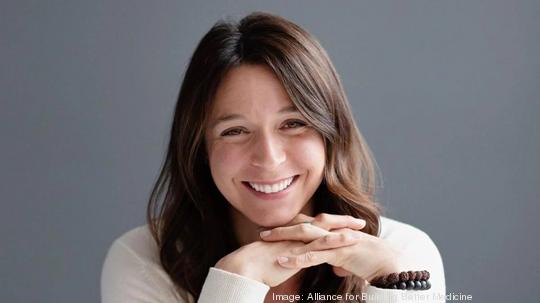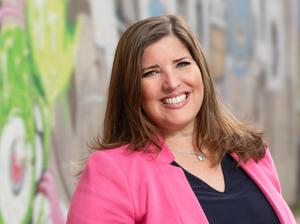
Joy Marie Polefrone earned a doctorate in chemistry from the University of Virginia and traveled the world as an executive at global health care giant Philips. In 2019, she quit Philips and moved to Richmond to be closer to family. She was recently hired as executive director of the Alliance for Building Better Medicine, a coalition of Richmond and Petersburg organizations working to build a research and manufacturing hub for essential medicines and their ingredients.
The organization was recently awarded $100 million in federal, local and private funding to develop an ecosystem to help advanced pharmaceutical manufacturing thrive. She recently spoke with Richmond Inno about the various factors that came together to set the table for pharmaceutical manufacturing in Central Virginia and the opportunities that might exists for entrepreneurs.
How did get involved with the alliance? I had been following their work through some of my connections. I was watching what they were doing. I had known about the work of Frank Gupton [co-founder of Phlow and CEO of the Medicines for All Institute at Virginia Commonwealth University] but didn’t know him. I knew Chandra Briggman [president and CEO of Activation Capital] from work that I had done with Activation Capital. I had the opportunity to see what they were doing, and I thought it was really fascinating. To be honest, before I dove into this, I had no idea where drugs were manufactured, and I didn’t know what was happening at VCU with Frank’s work at Medicines for All. I ended up working on several projects with [the alliance] where my background was useful.
Why do you think this whole pharmaceutical ecosystem has come together in the region? Frank Gupton is a pretty phenomenal visionary for work like this. He really thinks about how we can solve this problem. He then brings together people and resources to solve it. He doesn’t necessarily have all the pieces, and he recognizes that he doesn’t know all the things. And there were a couple of different things that happened. There was the timing of the work with the Gates Foundation. Frank and his team were doing stuff that nobody had done before. They were cutting the costs of medicines by like 40% for work that the Gates Foundation was doing in Africa.
And then the pandemic happened, right? Yep. There was this very real understanding around the challenges and concerns about pharmaceuticals being manufactured overseas. These conversations were happening even before the pandemic. It is mind-boggling how much has shifted over the last 30 years around pharmaceutical manufacturing. And then the pandemic happened. There were real concerns and challenges related to the supply chain. People were concerned about where we get these drugs and do we have a supply of them. When you combine those two issues, that created the opportunity for the federal government to plan an initiative and fund something that was adjacent to what Frank was doing. The goal is to really build up the supply of essential medicines.
But there are other pieces to the puzzle? We have a seat of pharmaceutical manufacturing in Petersburg that existed 30 years ago that kind of dried up. Companies went to other locations, but it has been reinvigorated with companies like Ampac [Fine Chemicals] being there. We also have technical capabilities centered around the universities with chemical engineering pharmaceuticals. VCU has one of the top pharmaceutical programs in the country. So, really, it’s the combination of world events and the people who are here.
What is your vision for the alliance? For me, I have worked in startups and one of the challenges is how do we get to operational execution. Once this group of people won this federal grant, there were so many pieces that they thought about [during the early funding rounds] and now the big money has come. Now we need to do a lot of this operational work. I am trying to figure out how do we create the scaffolding, the organizational support. There are different things that have been laid out, but those things are not inclusive of everything an ecosystem needs to grow and thrive. And a lot of those things we will not know until it is a year in.
One of the first things that I want to do is take the strategy that they created and look at everything we have on paper. I want to say: What did you want to do that we couldn’t do with those grants? How can we both execute on the grant applications that we are funded for and build the missing pieces?
Do you think that means bringing in a major pharmaceutical company as a partner or more fostering startups? I think major pharmaceutical companies might watch what we are doing, but I’m not sure this is going to be a space where they operate. But really, I have no idea. That has not been part of my thought process. To me, it’s been more about the supporting infrastructure around the work that is here. You have key starting material. We have a group that makes active pharmaceutical ingredients in AMPAC. That is one of the pieces of the equation. We have Civica, which does the work of formulating those drugs. Their primary customers are health systems. They are standing up their first manufacturing site in Petersburg. And then we have Phlow, which is really responsible for building up that supply of essential medicines for the federal government. I am then starting to think about all the other stuff that comes with delivering a product in a container and into someone’s medicine cabinet. Even say something like injectable insulin. How does that get put in a package? How do we get labels? What are the distribution models? These are all the other things around pharmaceutical [manufacturing] that need to exist. It is probably best for the existing capabilities to start talking about all the other things.
What role does Activation Capital play in this process? The role they played to date is pretty incredible. They have been the convener of all of these groups. My program is within the nonprofit area of Activation Capital. They stood up the alliance. Now we are trying to decide if the alliance should be an independent entity. They undertook significant resources to get the Go Virginia grant and submitting for the Building Resilient Infrastructure and Communities grants. They brought people together.
Where will this ecosystem be in five years? My hope is that in the next five years we have the ability to deliver on the vision that was shaped in the federal grant, which is that we have manufacturing and the ability to scale up. We have research and development. That is happening at VCU and around the biotech community. We can then take what has been created in a research setting and build the processes and steps to take that from research to full factory facility. And then we have manufacturing sites. We have that end-to-end capability within this region. It needs to be applied to the most essential areas and that can be essential medicines or rare diseases or clinical trial drugs or even generic manufacturing. We have to have the ability to go from research and then all the way through to scaling up the manufacturing. That would be a phenomenal accomplishment.
What opportunities do you see for founders and people who want to innovate in this space? People have to understand advanced manufacturing. It might sound like Charlie Brown and the “Waah waah” and “What did she just say?” It seems complicated, but it is the fact that when you start to scale these things up, you have got to have robotics. And you have software systems that revolve around the operations of large plants. You have got developing of data analytics to be able to understand and reconfigure chemistry. There is a ton of different spaces for which an entrepreneur could look at this problem and say, “Wow, I like solving problems in that particular space. I could imagine how that might look like in this. I have done that in a different industry and could apply that skill set to this industry.” That is where I get really excited. I can foresee in a few years where we go out into the community and say these are the challenges we have to solve for and help us think differently about them to solve them.
Do you see companies being formed out of the alliance’s effort? I hope there are entrepreneurs in this community that start to pay attention to the work that is happening in the advanced pharmaceutical manufacturing space and start to think about how we might solve problems that support that industry. I don’t know how that will happen. I don’t know that they will form in the next year. What I have learned about startups is there has to be some attachment to the problem for founders. They have to have an interest. They have to be curious about the problem. We have a community of humans in Richmond who are creative and innovative and have the capacity to apply different tools and skills to a problem that they have probably never heard of. I think if more people start to see the ecosystem built up and start to see it as interesting and they start to ideate around it, I think we will have the capacity to see companies start up in this space that I never could have imagined.
Where do you think workforce development fits into this? That was part of the grant. It’s the funding of a workforce development program. We have to make sure those things are getting off the ground. We have to apply a lot of the capabilities that we have at [Virginia State University] and VCU and the community college coalition. We need to include the rural community colleges to build the interest and capabilities for this industry to get off the ground. There is the really possibility of industry developing here.


